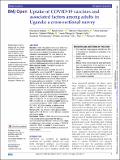Uptake of COVID-19 vaccines and associated factors among adults in Uganda: a cross-sectional survey
Author(s)
Ndejjo, Rawlance; Chen, Nuole; Kabwama, Steven N; Namale, Alice; Wafula, Solomon Tsebeni; Wanyana, Irene; Kizito, Susan; Kiwanuka, Suzanne N; Sambisa, William; Tsai, Lily L; Wanyenze, Rhoda K; ... Show more Show less
DownloadPublished version (515.2Kb)
Publisher with Creative Commons License
Publisher with Creative Commons License
Creative Commons Attribution
Terms of use
Metadata
Show full item recordAbstract
<jats:sec><jats:title>Objective</jats:title><jats:p>COVID-19 pandemic remains one of the most significant public health challenges ever faced globally. Vaccines are key to ending the pandemic as well as minimise its consequences. This study determined the uptake of COVID-19 vaccines and associated factors among adults in Uganda.</jats:p></jats:sec><jats:sec><jats:title>Design, setting and participants</jats:title><jats:p>We conducted a cross-sectional mobile phone survey among adults in Uganda.</jats:p></jats:sec><jats:sec><jats:title>Main outcome variable</jats:title><jats:p>Participants reported their uptake of COVID-19 vaccines.</jats:p></jats:sec><jats:sec><jats:title>Results</jats:title><jats:p>Of the participants contacted, 94% (1173) completed the survey. Overall, 49.7% had received COVID-19 vaccines with 19.2% having obtained a full dose and 30.5% an incomplete dose. Among the unvaccinated, 91.0% indicated intention to vaccinate. Major reasons for vaccine uptake were protection of self from COVID-19 (86.8%) and a high perceived risk of getting the virus (19.6%). On the other hand, non-uptake was related to vaccine unavailability (42.4%), lack of time (24.1%) and perceived safety (12.5%) and effectiveness concerns (6.9%). The factors associated with receiving COVID-19 vaccines were older age (≥65 years) (Adjusted Prevalence Ratio (APR)=1.32 (95% CI: 1.08 to 1.61)), secondary (APR=1.36 (95% CI: 1.12 to 1.65)) or tertiary education (APR=1.62 (95% CI: 1.31 to 2.00)) and health workers as a source of information on COVID-19 (APR=1.26 (95% CI: 1.10 to 1.45)). Also, reporting a medium-income (APR=1.24 (95% CI: 1.02 to 1.52)) and residence in Northern (APR=1.55, 95% CI: 1.18 to 2.02) and Central regions (APR=1.48, 95% CI: 1.16 to 1.89) were associated with vaccine uptake.</jats:p></jats:sec><jats:sec><jats:title>Conclusions</jats:title><jats:p>Uptake of COVID-19 vaccines was moderate in this sample and was associated with older age, secondary and tertiary education, medium-income, region of residence and health workers as a source of COVID-19 information. Efforts are needed to increase access to vaccines and should use health workers as champions to enhance uptake.</jats:p></jats:sec>
Date issued
2023-03Department
Massachusetts Institute of Technology. Department of Political ScienceJournal
BMJ Open
Publisher
BMJ
Citation
Ndejjo, Rawlance, Chen, Nuole, Kabwama, Steven N, Namale, Alice, Wafula, Solomon Tsebeni et al. 2023. "Uptake of COVID-19 vaccines and associated factors among adults in Uganda: a cross-sectional survey." BMJ Open, 13 (3).
Version: Final published version